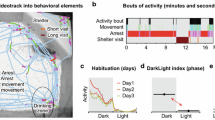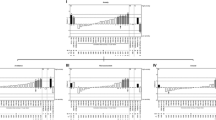Abstract
When placed singly into a novel environment, male mice of the C57BL/6 strain have consistently higher frequencies for rearing behavior than those of the DBA/2 strain. Hybrids also have high scores for this exploratory act, indicating dominance of alleles contributing to high rearing frequencies. Judging from the variances of the nonsegregating populations, a significant genotype-environment interaction was present. From raw data, the degree of genetic determination was estimated to be about 77±12%.
Polygenes responsible for high rearing scores in the C57BL strain were transferred to a DBA background: By using a system of crossing, repeated backcrossing for five generations, and inbreeding for six generations, with concomitant directional selection, a high-scoring and a low-scoring subline were established. These lines will be used for further genetic analyses.
Rèsumè
Placées solitairement dans un nouvel entourage, les souris mâles de la souche-C57BL/6 montrent régulièrement une plus haute fréquence de l'élément de comportement nommé “reconnaissance” que celles de la souche-DBA/2. Les hybrides aussi montrent de hautes fréquences pour cette action exploratrice, ce qui indique une dominance d'allèles contribuant à une haute fréquence des “reconnaissances”. A en juger d'après les variations des populations non-ségrégantes, une interaction significative entre le génotype et l'ambiance était présente. Partant de données crues on a calculé la détermination génétique à environ 77±12%.
Des polygènes responsables des hautes fréquences de l'action de “reconnaissance” dans la souche-C57BL furent transférés au milieu génotypique de la souche-DBA: Par l'emploi d'un système de croisement, de croisement de retour réitéré pour cinq générations et de croisement consanguin pour six générations avec une sélection dirigée concomitante, on put établir une lignée à hautes fréquences et une lignée à basses fréquences. Ces lignées seront utilisées pour des analyses génétiques ultérieures.
Zusammenfassung
Werden männliche Mäuse des Stammes C57BL/6 einzeln in eine neue Umgebung gebracht, so liefern sie regelmässig höhere Frequenzen der Verhaltenskomponente “Sichern” als DBA/2-Mäuse. Da uch bei Bastard-Tieren eine hohe Frequenz dieser dem Explorierungsverhalten zugeordneten Komponente beobachtet wird, ist Dominanz der Allele anzunehmen, die diese hohen Frequenzen des “Sicherns” kontrollieren. Beim Vergleich der Varianzen der nicht-spaltenden Populationen wird eine deutliche Abhängigkeit der Milieu-Effekte vom Genotyp gefunden. Das untransformierte Zahlenmaterial lässt auf eine genetische Determination von ca. 77±12% schliessen.
Polygene, die die hohen Frequenzen des “Sicherns” in Stamm C57BL kontrollieren, wurden in den Stamm DBA eingeführt: Unter Zuhilfenahme eines Systems von Kreuzung, wiederholter Rückkreuzung über fünf Generationen und Inzucht über sechs Generationen mit gleichzeitiger gerichteter Selektion, konneten eine Linie mit einer hohen und eine Linie mit einer niedrigen “Sichern”-Frequenz gezüchtet werden. Diese beiden Linien sollen für weitere genetische Analysen verwendet werden.
Similar content being viewed by others
References
Abeelen, J. H. F. v. (1966). Effects of genotype on mouse behavior.Anim. Behav. 14, 218–25.
Abeelen, J. H. F. v. Kroes, H. W. (1967). Albinism and mouse behaviour.Genetica 38, 419–29.
Broadhurst, P. L. (1960). Applications of biometrical genetics to the inheritance of behaviour. InExperiments in Personality Vol. I (ed. H. J. Eysenck). Routledge & Kegan Paul, London: pp. 3–102.
Bruell, J. H. (1962). Dominance and segregation in the inheritance of quantitative behavior in mice. InRoots of Behavior (ed. E. L. Bliss). Hoeber & Harper, New York: pp. 48–67.
Chai, C. K. (1968). Analysis of quantitative inheritance of body size in mice. V. Effects of small numbers of polygenes on similar genetic backgrounds.Genet. Res., Camb. 11, 239–46.
Falconer, D. S. (1963). Quantitative inheritance. InMethodology in Mammalian Genetics (ed. W. J. Burdette). Holden-Day, San Francisco: pp. 193–216.
Guttman, R., Lieblich, I. E. Naftali, G. (1969). Variation in activity scores and sequences in two inbred mouse strains, their hybrids, and backcrosses.Anim. Behav.,17, 374–85.
Manosevitz, M. & Lindzey, G. (1967). Genetics of hoarding: A biometrical analysis.J. comp. physiol. Psychol. 63, 142–4.
Mather, K. (1949).Biometrical Genetics. Methuen, London.
McClearn, G. E. (1961). Genotype and mouse activity.J. comp. physiol. Psychol. 54, 674–6.
—, (1965). Genotype and mouse behaviour. InGenetics Today, Proc. XI Int. Congr. Genet. Vol. 3 (ed. S. J. Geerts). Pergamon, Oxford, pp. 795–805.
Roberts, R. C. (1966). The limits to artificial selection for body weight in the mouse. II. The genetic nature of the limits.Genet. Res., Camb. 8, 361–75.
Siegel, S. (1956).Nonparametric Statistics for the Behavioral Sciences. McGraw-Hill, New York.
Staats, J. (1958). Behaviour studies on inbred mice: A selected bibliography.Anim. Behav. 6, 77–84.
Staats, J. (1963). Behaviour studies on inbred mice: A selected bibliography, II.Anim. Behav. 11, 484–90.
Thoday, J. M. (1961). Location of polygenes.Nature, Lond. 191, 368–70.
Author information
Authors and Affiliations
Rights and permissions
About this article
Cite this article
van Abeelen, J.H.F. Genetics of rearing behavior in mice. Behav Genet 1, 71–76 (1970). https://doi.org/10.1007/BF01067372
Issue Date:
DOI: https://doi.org/10.1007/BF01067372




